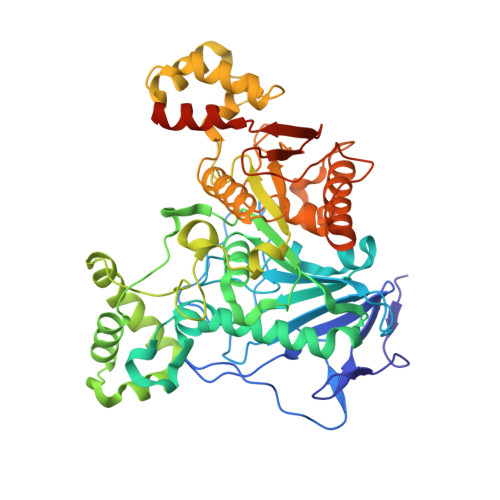An Esterase from Anaerobic Clostridium Hathewayi Can Hydrolyze Aliphatic-Aromatic Polyesters.
Perz, V., Hromic, A., Baumschlager, A., Steinkellner, G., Pavkov-Keller, T., Gruber, K., Bleymaier, K., Zitzenbacher, S., Zankel, A., Mayrhofer, C., Sinkel, C., Kueper, U., Schlegel, K., Ribitsch, D., Guebitz, G.M.(2016) Environ Sci Technol 50: 2899
- PubMed: 26878094
- DOI: https://doi.org/10.1021/acs.est.5b04346
- Primary Citation of Related Structures:
5A2G - PubMed Abstract:
Recently, a variety of biodegradable polymers have been developed as alternatives to recalcitrant materials. Although many studies on polyester biodegradability have focused on aerobic environments, there is much less known on biodegradation of polyesters in natural and artificial anaerobic habitats. Consequently, the potential of anaerobic biogas sludge to hydrolyze the synthetic compostable polyester PBAT (poly(butylene adipate-co-butylene terephthalate) was evaluated in this study. On the basis of reverse-phase high-performance liquid chromatography (RP-HPLC) analysis, accumulation of terephthalic acid (Ta) was observed in all anaerobic batches within the first 14 days. Thereafter, a decline of Ta was observed, which occurred presumably due to consumption by the microbial population. The esterase Chath_Est1 from the anaerobic risk 1 strain Clostridium hathewayi DSM-13479 was found to hydrolyze PBAT. Detailed characterization of this esterase including elucidation of the crystal structure was performed. The crystal structure indicates that Chath_Est1 belongs to the α/β-hydrolases family. This study gives a clear hint that also micro-organisms in anaerobic habitats can degrade manmade PBAT.
Organizational Affiliation:
Austrian Centre of Industrial Biotechnology ACIB , Konrad Lorenz Strasse 20, 3430 Tulln, Austria.















